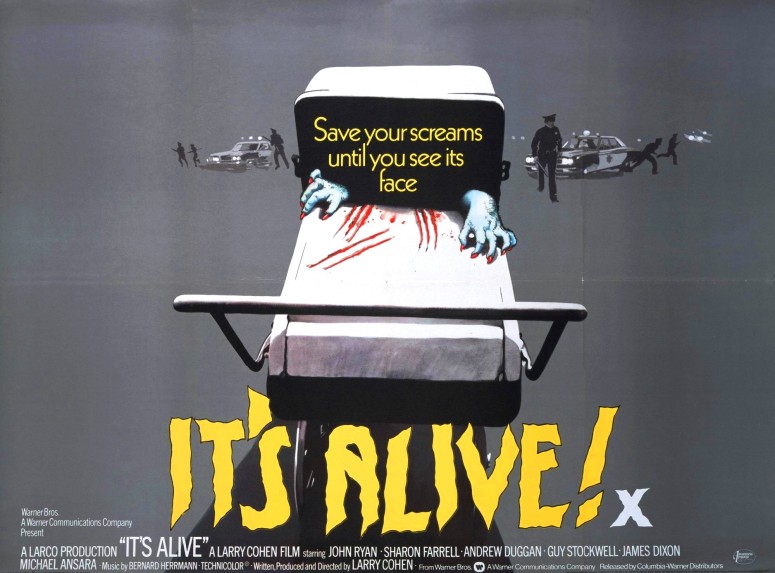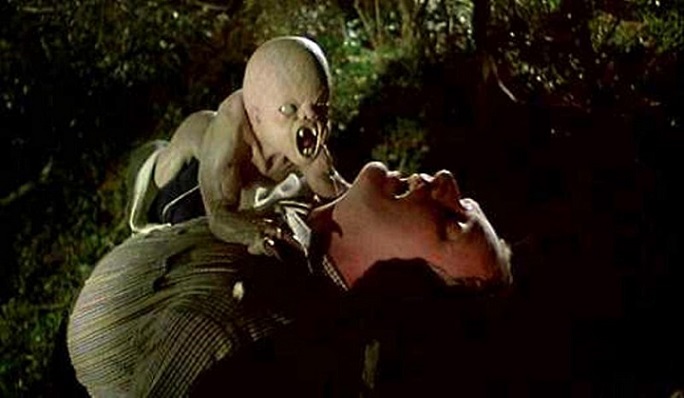
A monstrous baby is the subject of Larry Cohen’s It’s Alive (1974). The film also presents the traditional American family as monstrous. But even before the narrative begins, the title sequence appears to place the blame on the male half of the heterosexual couple. Small objects move about the screen as the opening credits roll over them. They look like nothing so much as sperm darting around in a Petri dish. Then they morph into what look like flashlights in a dark room.
At first, this is undecipherable, but it becomes clear later in the film. The flashlights are those of the LAPD officers searching for the monstrous baby in the now-iconic Los Angeles Aqueduct. They find no Reservoir Dogs, but they do find the infant monster. But, according to the narrative, it’s the male’s genetic contribution that causes the baby’s abject transformation in the first place.
We know this because of the father’s reaction to his monstrous offspring. Frank Davis (John Ryan) first reacts with guilt and shame. The man’s world in which he lives blames him for the baby’s defects. So he projects these intolerable feelings onto his child. Thereafter, his reaction changes to anger and then homicidal rage aimed at his monstrous offspring. He’ll redeem himself by killing his own son. It is clear that he has no concern about doing so. Neither does he give a thought to the opinion or feelings of his wife Lenore (Sharon Farrell), the baby’s mother. With its patriarch threatened, the nuclear family is in danger of breaking down.
Still, It’s Alive spreads the blame for the social meltdown of the early 1970s into the wider American culture beyond the nuclear family. Medical science takes a hit. Lenore’s obstetrician (Shamus Locke) embodies the paternalistic attitude typical of the male doctor – female patient ‘relationship’ of the era. Despite the slaughter of his colleagues, all he cares about is getting his hands on the (dead) baby for research purposes. Then there’s the pharmaceutical executive (Robert Emhardt), who wants it subjected to “absolute destruction” to hide his company’s toxic contribution to the monstrosity. It’s not difficult to glimpse the thalidomide debacle of the 50s and 60s hiding behind this on-screen representation. Over-medication with other drugs (for both birth control and fertility) and the ubiquity of pesticides and other man-made pollutants also take a share of the blame.
The final line of the film takes the onus off the Davies family and places it squarely on dominant American culture in general. It’s spoken by Lieutenant Perkins (James Dixon), the leader of the dragnet. Earlier in the film, he hints that law enforcement can’t handle the monstrosity that toxic America has created: “Hunting and killing babies doesn’t seem to be my specialty.” At the end, he confirms that the monstrous Other is still “alive” and kicking, despite the police’s assassination of the Davis baby: “Another one’s been born in Seattle.”
With this use of the Pandora’s Box motif, writer-director Cohen implies that the catastrophe is systemic and thus inevitable. It’s built into the structure. As with many other horror films of the 1970s, normality and the monster are one and the same.



I remember this film! When I was growing up it would be at the midnight show along with Eraserhead and Reefer Madness. A couple of years when I caught it on cable I wondered what the fuss was all about.
Yes, social commentary is rampant in the film. The subtext is alive and thriving. Probably aimed at the state of affairs in the world. Now I believe this would just be campy fun.
Good review!
LikeLiked by 1 person
Thanks! I agree that this film is also great (if unintentional) campy fun!
LikeLiked by 1 person
Those old 1970s horror flicks usually end up being that way.
LikeLiked by 1 person
I also love Eraserhead!
LikeLiked by 1 person
Me too! It is like one PSA, albeit a weird one for birth control, lol.
LikeLiked by 1 person